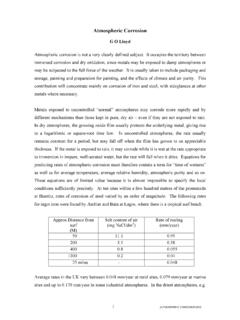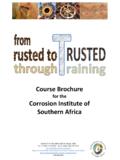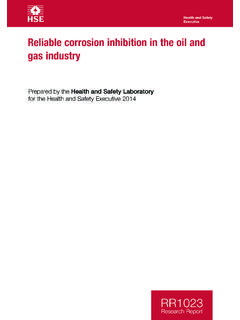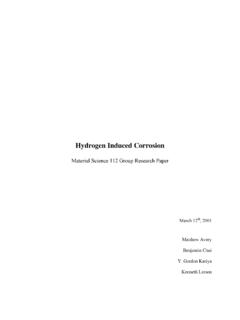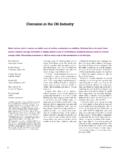Transcription of Introduction to Corrosion Monitoring - alspi.com
1 Introduction to Corrosion MonitoringWhat is Corrosion Monitoring ?The field of Corrosion measurement, control, and prevention covers a very broad spectrum of tech-nical activities. Within the sphere of Corrosion control and prevention, there are technical options such as cathodic and anodic protection, materials selection, chemical dosing and the application of internal and external coatings. Corrosion measurement employs a variety of techniques to determine how corrosive the environment is and at what rate metal loss is being experienced. Corrosion mea-surement is the quantitative method by which the effectiveness of Corrosion control and prevention techniques can be evaluated and provides the feedback to enable Corrosion control and prevention methods to be wide variety of Corrosion measurement techniques exists, including.
2 Non Destructive Testing Analytical Chemistry Ultrasonic testing pH measurement Radiography Dissolved gas (O2, CO2, H2S) Thermography Metal ion count (Fe2+, Fe3+) Eddy current/magnetic flux Microbiological analysis Intelligent pigsOperational Data Fluid Electrochemistry pH Potential measurement Flow rate (velocity) Potentiostatic measurements Pressure Potentiodynamic measurements Temperature impedanceCorrosion Monitoring Weight loss coupons Electrical resistance Linear polarization Hydrogen penetration Galvanic currentSome Corrosion measurement techniques can be used on-line, constantly exposed to the process stream, while others provide off-line measurement, such as that determined in a laboratory analysis.
3 Some techniques give a direct measure of metal loss or Corrosion rate, while others are used to infer that a corrosive environment may Monitoring is the practice of measuring the corrosivity of process stream conditions by the use of probes which are inserted into the process stream and which are continuously exposed to the process stream Monitoring probes can be mechanical, electrical, or electrochemical devices. Corrosion Monitoring techniques alone provide direct and online measurement of metal loss/ Corrosion rate in industrial process , a Corrosion measurement, inspection and maintenance program used in any industrial facility will incorporate the measurement elements provided by the four combinations of on-line/off-line, direct/indirect measurements.
4 Corrosion Monitoring Direct, On-line Non Destructive Testing Direct, Off-line Analytical Chemistry Indirect, Off-line Operational Data Indirect, On-lineIn a well controlled and coordinated program, data from each source will be used to draw meaningful conclusions about the operational Corrosion rates with the process system and how these are most effectively Need for Corrosion MonitoringThe rate of Corrosion dictates how long any process equipment can be usefully and safely operated. The measurement of Corrosion and the action to remedy high Corrosion rates permits the most cost effective plant operation to be achieved while reducing the life-cycle costs associated with the Monitoring techniques can help in several ways:(1) by providing an early warning that damaging process conditions exist which may result in a Corrosion - induced failure.
5 (2) by studying the correlation of changes in process parameters and their effect on system corrosivity.(3) by diagnosing a particular Corrosion problem, identifying its cause and the rate controlling parameters, such as pressure, temperature, pH, flow rate, etc.(4) by evaluating the effectiveness of a Corrosion control/prevention technique such as chemical inhibition and the determination of optimal applications.(5) by providing management information relating to the maintenance requirements and ongoing condition of - 2 Corrosion - 3 Corrosion Monitoring TechniquesA large number of Corrosion Monitoring techniques exist.
6 The following list details the most com-mon techniques which are used in industrial applications: Corrosion Coupons (weight loss measurements) Electrical Resistance (ER) Linear Polarization Resistance (LPR) Galvanic (ZRA) Hydrogen Penetration Microbial Sand/ErosionOther techniques do exist, but almost all require some expert operation, or otherwise are not suffi-ciently rugged or adaptable to plant the techniques listed above, Corrosion coupons, ER, and LPR form the core of industrial corro-sion Monitoring systems. The four other techniques are normally found in specialized applications which are discussed Corrosion Monitoring techniques have been successfully applied and are used in an increasing range of applications because: The techniques are easy to understand and implement.
7 Equipment reliability has been demonstrated in the field environment over many years of operational application. Results are easy to interpret. Measuring equipment can be made intrinsically safe for hazardous area operation. Users have experienced significant economic benefit through reduced plant down time and plant life Coupons (Weight Loss)The Weight Loss technique is the best known and simplest of all Corrosion Monitoring techniques. The method in-volves exposing a specimen of material (the coupon) to a process environment for a given duration, then removing the specimen for analysis. The basic measurement which is determined from Corrosion coupons is weight loss; the weight loss taking place over the period of exposure being expressed as Corrosion simplicity of the measurement offered by the Corrosion coupon is such that the coupon tech-nique forms the baseline method of measurement in many Corrosion Monitoring - 4 The technique is extremely versatile, since weight loss coupons can be fabricated from any commer-cially available alloy.
8 Also, using appropriate geometric designs, a wide variety of Corrosion phe-nomena may be studied which includes, but is not limited to: Stress-assisted Corrosion Bimetallic (galvanic) attack Differential aeration Heat-affected zonesAdvantages of weight loss coupons are that: The technique is applicable to all environments - gases, liquids, solids/particulate flow. Visual inspection can be undertaken. Corrosion deposits can be observed and analyzed. Weight loss can be readily determined and Corrosion rate easily calculated. Localized Corrosion can be identified and measured. Inhibitor performance can be easily a typical Monitoring program, coupons are exposed for a 90-day duration before being removed for a laboratory analysis.
9 This gives basic Corrosion rate measurements at a frequency of four times per year. The weight loss resulting from any single coupon exposure yields the average value of Corrosion occurring during that exposure. The disadvantage of the coupon technique is that, if a Corrosion upset occurs during the period of exposure, the coupon alone will not be able to identify the time of occurrence of the upset, and depending upon the peak value of the upset and its duration, may not even register a statistically significant increased weight , coupon Monitoring is most useful in environments where Corrosion rates do not signifi-cantly change over long time periods.
10 However, they can provide a useful correlation with other techniques such as ER and LPR Resistance (ER) MonitoringER probes can be thought of as electronic Corrosion coupons. Like coupons, ER probes provide a basic measurement of metal loss, but unlike coupons, the value of metal loss can be measured at any time, as frequently as required, while the probe is in-situ and permanently exposed to the process this diagram, a standard ER instrument is connected to a 40 mil wire loop element which has a useful life of 10 mils. The instrument still reads close to zero because the element is new. Here the instrument reads around half-scale, indicating that the element has experienced about 5 mils of metal loss or about half of its useful life.





